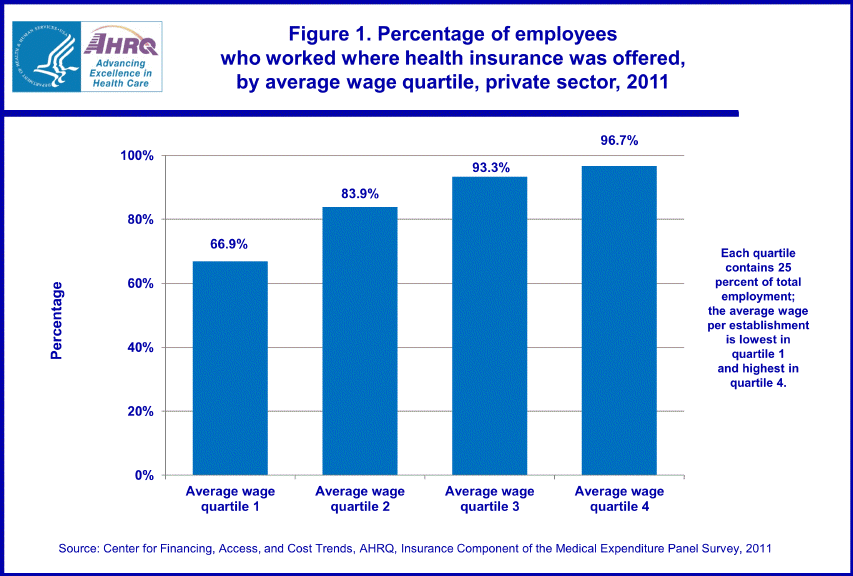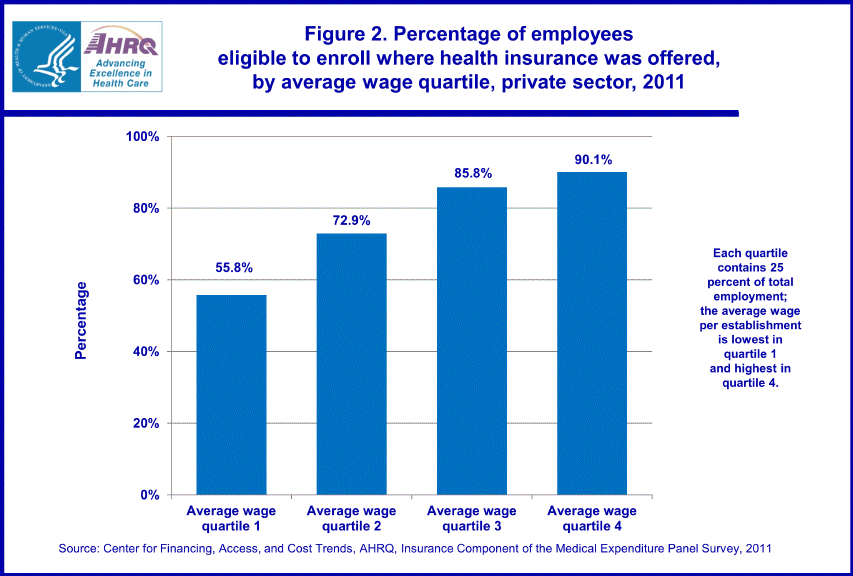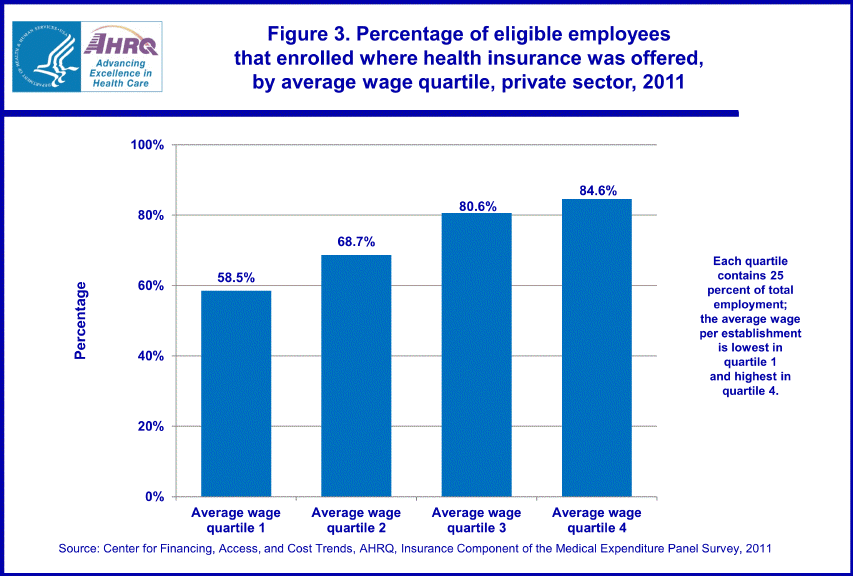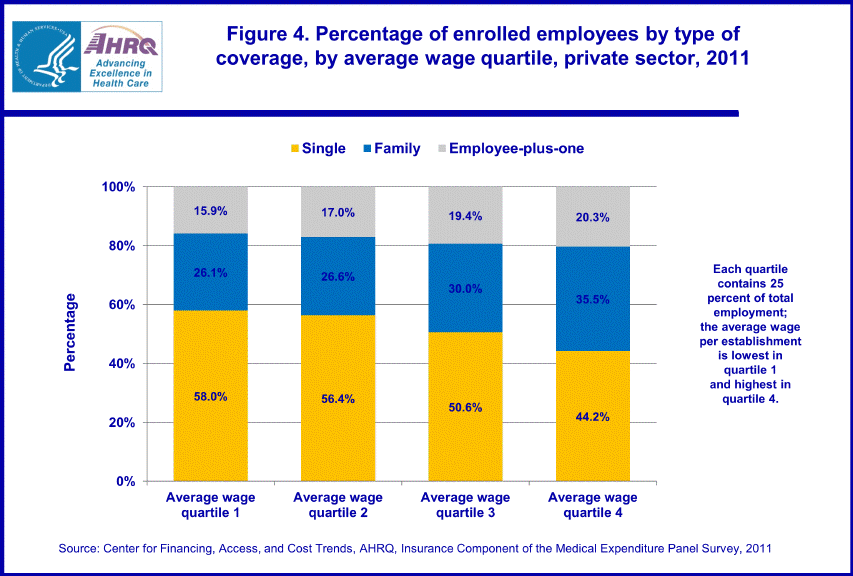
|
|
Font Size:
|
||||
|
|
|
|
||||
STATISTICAL BRIEF #394:
Differences in Employer-Sponsored Health Insurance by Average Wage, Private Sector, 2011
Highlights
- As the average wage rose across quartiles, so did the percentage of private-sector employees working where insurance was offered in 2011. The percentage of employees who were eligible to enroll in establishments where health insurance was offered showed the same pattern as offer rates in 2011—the higher the wage quartile, the greater the percentage of eligible employees.
- The percentage of eligible employees that enrolled rose from 58.5 percent in average wage quartile 1 to 68.7 percent in average wage quartile 2 to 80.6 percent in average wage quartile 3 to 84.6 percent in average wage quartile 4.
- Single coverage was chosen more often than employee-plus-one or family coverage across all four quartiles. However, it was selected much less often by employees in quartile 3 and quartile 4 than those in quartiles 1 and 2.
Introduction
Certain characteristics of an employer—such as firm size, industry, union coverage, and location—are associated with whether health insurance is offered to employees, whether employees take-up insurance, the cost to employers and employees of coverage, and the features of offered plans (such as deductibles, copays, and benefits included).Another factor linked to variations in health insurance coverage among employers is the average wage per employee. Using 2011 data from the Insurance Component of the Medical Expenditure Panel Survey (MEPS-IC), this Statistical Brief examines differences in employer-sponsored health insurance for employees of private-sector establishments (business locations) as characterized by the average wage in each establishment. The average wage is total payroll divided by the number of employees in the establishment.
For this analysis, employment is divided into four equally sized groups or quartiles. Each quartile contains 25 percent of total employment in the private sector in 2011, or about 27 million employees. Each succeeding quartile consists of employees in establishments with progressively higher average wages. That is, quartile 1 contains the 25 percent of employment within the establishments with the lowest average wage per employee, while quartile 4 contains the 25 percent of employment within the establishments with the highest average wage per employee.
Only those differences between average wage quartiles that are statistically significant at the 0.05 significance level are discussed. See the Definitions section for a more detailed explanation of how the average wage quartiles were constructed.
Findings
In quartile 1, the group with the lowest average wage, the percentage of employees working where insurance was offered was 66.9 percent (figure 1). As the average wage rose across quartiles, so did the percentage of employees working where insurance was offered—83.9 percent in quartile 2, 93.3 percent in quartile 3, and 96.7 percent in quartile 4.In private-sector establishments that offer insurance, not all employees are eligible to enroll. Common eligibility criteria include a minimum number of hours worked per pay period and/or a minimum length of service period with the employer. The percentage of employees who were eligible to enroll in establishments where health insurance was offered showed the same pattern as offer rates in 2011—the higher the wage quartile, the greater the percentage of eligible employees. For quartile 1, 55.8 percent of employees were eligible to enroll in establishments that offered insurance (figure 2). The comparable percentages were 72.9 percent for quartile 2, 85.8 percent for quartile 3, and 90.1 percent for quartile 4.
While the employer decides whether to offer health insurance and identifies which employees are eligible to enroll, each eligible employee determines whether or not to take coverage. The decision by eligible employees to enroll in employer-sponsored insurance showed an upward trend by average wage quartile in 2011. The percentage of eligible employees that enrolled rose from 58.5 percent in quartile 1 to 68.7 percent in quartile 2 to 80.6 percent in quartile 3 to 84.6 percent in quartile 4 (figure 3).
Single coverage was the most commonly selected type across all four quartiles in 2011. However, it was selected much less often by employees in quartile 3 and quartile 4 than those in quartiles 1 and 2 (figure 4). Only 44.2 percent of employees took single coverage in quartile 4 versus 58.0 percent in quartile 1.
In contrast to single coverage, family and employee-plus-one coverage were more common in the higher quartiles. Within quartile 4, 35.5 percent of employees chose family coverage and 20.3 percent chose employee-plus-one coverage. The comparable numbers for quartile 1 were 26.1 percent and 15.9 percent, respectively.
Data Source
The statistics in this Brief are estimates from the 2011 MEPS-IC. All information comes from tables that are available on the MEPS Web site at http://www.meps.ahrq.gov/mepsweb/survey_comp/Insurance.jsp. This Brief is limited to a discussion of private-sector statistics; tables containing information on employer-sponsored health insurance for State and local government employees will be published in November 2012.Definitions
Average wage quartilesQuartiles are groups of establishments, each of which contains one quarter of total private-sector employment. The following process was used to determine the establishments within each of these four quartiles:
- The establishments were placed in order from lowest to highest average wage per employee (total payroll divided by number of employees, both full-time and part-time).
- Starting with the establishment with the lowest average wage, employment was summed until the cumulative employment of the establishments on the list was 25 percent of the total employment of all establishments. The establishments on the list to that point are considered to be in quartile 1.
- Quartile 2 begins with the next establishment on the list and includes all establishments from that point on the list until the cumulative employment reaches 50 percent of the total.
- Quartile 3 includes all establishments after quartile 2 and ends with the establishment that brings the cumulative employment to 75 percent of the total.
- Quartile 4 includes all establishments above quartile 3.
Eligible employee
Not all employees may be eligible to enroll in health insurance coverage at those establishments where it is offered. Common eligibility criteria include a minimum number of hours worked per pay period or a minimum length of service with the employer. An employee that is eligible to enroll during the plan enrollment period is considered eligible even if the employer is surveyed at other times of the year.
Employee
A person on the actual payroll. Excludes temporary and contract workers but includes the owner or manager if that person works at the firm.
Employee-plus-one coverage
Health insurance that covers the employee plus one family member at a lower premium level than family coverage. This family member could be a spouse or child.
Employer
An establishment in a private sector firm.
Establishment
A particular workplace or physical location where business is conducted or services or industrial operations are performed. A firm consists of one or more business establishments under common ownership or control, including the company headquarters and all divisions, subsidiaries, and branches. A firm may consist of a single-location establishment, in which case the establishment and firm are identical.
Family coverage
Health insurance that covers the employee and the employee’s family.
Health insurance
An insurance contract that provides hospital and/or physician coverage to an employee for an agreed-upon fee (premium) for a defined benefit period.
Single coverage
Health insurance that covers the employee only.
About MEPS-IC
The MEPS-IC is a survey of business establishments and governments that collects information on employer-sponsored health insurance, such as whether insurance is offered, enrollments, types of plans, and premiums. The survey is conducted annually by the U.S. Census Bureau under the sponsorship of the Agency for Healthcare Research and Quality (AHRQ). A total sample of approximately 42,000 private-sector establishments was selected for the 2011 survey, with 6.4 percent of the sample determined to be out-of-scope during the data collection process. The response rate for the private sector was 81.7 percent of the remaining in-scope sample units.For more information on this survey, see MEPS Methodology Reports 6, 8, 10, 14, 17, and 18 on the MEPS Web site at http://www.meps.ahrq.gov/mepsweb/data_stats/Pub_ProdLookup_Results.jsp?ProductType=Methodology%20Report&Comp=Insurance and Insurance Component Survey Basics at http://www.meps.ahrq.gov/mepsweb/survey_comp/Insurance.jsp.
Suggested Citation
Crimmel, B.L. Differences in Employer-Sponsored Health Insurance by Average Wage, Private Sector, 2011. Statistical Brief #394. November 2012. Agency for Healthcare Research and Quality, Rockville, MD. http://www.meps.ahrq.gov/mepsweb/data_files/publications/st394/stat394.shtmlAHRQ welcomes questions and comments from readers of this publication who are interested in obtaining more information about access, cost, use, financing, and quality of health care in the United States. We also invite you to tell us how you are using this Statistical Brief and other MEPS data and tools and to share suggestions on how MEPS products might be enhanced to further meet your needs. Please e-mail us at MEPSProjectDirector@ahrq.hhs.gov or send a letter to the address below:
Steven B. Cohen, PhD, Director
Center for Financing, Access, and Cost Trends
Agency for Healthcare Research and Quality
540 Gaither Road
Rockville, MD 20850
 |
||||||||||||||||||||||||||||
|
||||||||||||||||||||||||||||
|
|
||||||||||||||||||||||||||||
 |
||||||||||||||||||||||||||||
|
||||||||||||||||||||||||||||
|
|
||||||||||||||||||||||||||||
 |
||||||||||||||||||||||||||||
|
||||||||||||||||||||||||||||
|
|
||||||||||||||||||||||||||||
 |
||||||||||||||||||||||||||||
|
||||||||||||||||||||||||||||
|
|
||||||||||||||||||||||||||||


